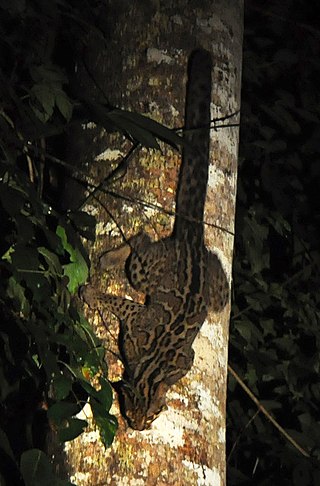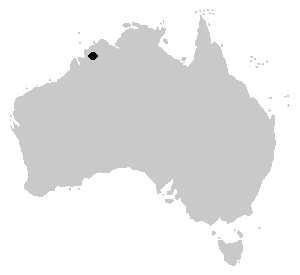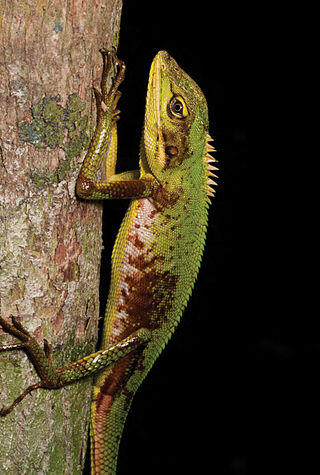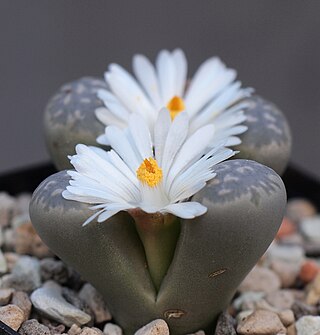
The marbled cat is a small wild cat native from the eastern Himalayas to Southeast Asia, where it inhabits forests up to an elevation of 2,500 m (8,200 ft). As it is present in a large range, it has been listed as Near Threatened on the IUCN Red List since 2015.

Tomopterna is a genus of frogs from sub-Saharan Africa.

Uperoleia marmorata commonly known as the marbled toadlet, is only known by the holotype collected in the Kimberley region of Western Australia by Gray in 1841.

The giant mottled eel, also known as the marbled eel, is a species of tropical anguillid eel that is found in the Indo-Pacific and adjacent freshwater habitats.

Scaphiophryne marmorata is a species of frog in the family Microhylidae. It is commonly known as the green burrowing frog and the marbled rain frog. It is endemic to Madagascar. It is classified as "Vulnerable" by the IUCN as it is threatened by habitat loss.

Nannophrys marmorata, commonly known as Kirtisinghe's rock frog or marbled streamlined frog, is a species of frog endemic to Sri Lanka. It used to be placed in the large frog family Ranidae but a phylogenetic study was undertaken using DNA sequences and it is now included in the family Dicroglossidae. Its natural habitats are tropical moist lowland forests, moist montane forests, rivers and streams. It is threatened by habitat loss.

The marbled electric ray is a species of electric ray in the family Torpedinidae found in the coastal waters of the eastern Atlantic Ocean from the North Sea to South Africa. This benthic fish inhabits rocky reefs, seagrass beds, and sandy and muddy flats in shallow to moderately deep waters. It can survive in environments with very little dissolved oxygen, such as tidal pools. The marbled electric ray has a nearly circular pectoral fin disc and a muscular tail that bears two dorsal fins of nearly equal size and a large caudal fin. It can be identified by the long, finger-like projections on the rims of its spiracles, as well as by its dark brown mottled color pattern, though some individuals are plain-colored. Males and females typically reach 36–38 cm (14–15 in) and 55–61 cm (22–24 in) long respectively.

Spharagemon collare, the mottled sand grasshopper, is found in sandy-soiled, grassy areas of northern United States and southern Canada. They are known to be a minor pest of wheat crops; however, populations are rarely large enough to cause appreciable damage.
The marbled frog is a species of ground-dwelling frog in the family Myobatrachidae native to northern and north-eastern Australia, and southern New Guinea.

Bronchocela marmorata, marbled crested lizard, marbled bloodsucker or marbled agamid lizard is a species of lizard. It is endemic to the Philippines, where it inhabits lowland dipterocarp and montane forests at elevations 400 to 800 m above mean sea level. It is typically found on branches and leaves of trees. It feeds on insects and is oviparous, digging the soil to lay its eggs at the base of trees.
Oedodera marmorata, also known as the marbled gecko, is a species of gecko endemic to New Caledonia.

Trimerotropini is a tribe of band-winged grasshoppers in the family Acrididae. There are at least 70 described species in Trimerotropini: found in the western Americas.

Spharagemon crepitans, commonly known as the crepitating grasshopper, is a species of band-winged grasshopper in the family Acrididae. It is found in North America.

Spharagemon is a genus of band-winged grasshoppers in the family Acrididae. There are about 9 described species in Spharagemon.
Enoplognatha marmorata, the marbled cobweb spider, is a species of cobweb spider in the family Theridiidae. It is found in North America.
Spharagemon bunites is a species of band-winged grasshopper in the family Acrididae. It is found in North America.
Spharagemon campestris, the campestral grasshopper, is a species of band-winged grasshopper in the family Acrididae. It is found in North America.

Spharagemon bolli, known generally as the Boll's grasshopper or Boll's locust, is a species of band-winged grasshopper in the family Acrididae. It is found in North America.

Lithops marmorata is a species of succulent pebble plant. It is native to the Northern Cape Province of South Africa. The specific name is derived from the Latin word marmorata meaning "marbled".

Dasyatis marmorata, the marbled stingray, is a species of stingray of the family Dasyatidae. Its geographic range covers the central and south-eastern Atlantic, from Morocco to South Africa. It is also present in the coastal waters of southern Mediterranean Sea and the Levantine Basin. This bottom-dweller generally inhabits sandy or muddy flats near rocky reefs and kelp forests, to a depth of 50 m (164 ft).














